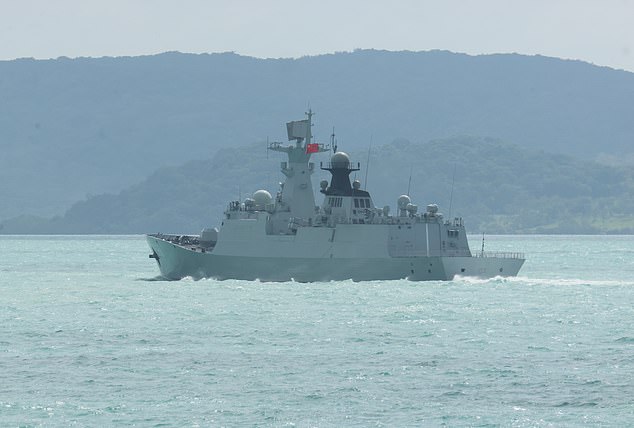‘You’re going to need a bigger boat…’
That’s the message delivered by a flotilla of Chinese warships that have been sailing around Australia for the last few weeks.
The Royal Australian Navy has been relegated to a spectator role as one of the world’s most-lethal warships penetrated further south than any previous Chinese voyage and engaged in live-fire exercises a few hundred miles off Sydney.
Even as Australia’s political leaders attempted to downplay the threat, it emerged that not only did China not deem them worthy of a polite heads-up about the drills via official channels, but that it took 40 minutes for the Defence Department to learn the firing had started.
And that’s only because commercial pilots raised the alarm.
The Royal New Zealand Navy, to whom monitoring of the flotilla had been outsourced, took 90 minutes to let Defence know.
That sort of delay in a hostile situation would be disastrous. From where that firing took place, the destroyer Zunyi could on its own erase from the map every city on Australia’s east coast from Townsville to Hobart using China’s nuclear capable CJ-10 cruise missiles (equivalent to the US’s famed Tomahawk).
The Zunyi, which the US Naval Institute describes as ‘among the most formidable warships afloat’, can fire 112 cruise missiles from its array of vertical launchers. That’s equivalent to half the total number of Tomahawks Australia has ordered for its entire armed forces. In one ship.

The flotilla of Chinese warships that has been sailing around Australia for the last few weeks has exposed a terrifying truth about Australia’s defence capability
China has eight such vessels, with two more recently launched and more under construction. The frigate that accompanied the Zunyi is one of more than 40 China operates, each boasting 32 vertical missile launchers.
Japan’s next destroyer will have 128 missile launchers, matching the armament of South Korea’s destroyers.
Australia’s most-formidable ships, the three Hobart-class air-warfare destroyers, have 48 vertical missile launchers. Its Collins-class submarines have no vertical launch capability and there are no plans to equip them to fire anything other than anti-ship missiles or torpedoes.
The basic fact is the Royal Australian Navy has across recent decades been badly let down by both sides of politics. The Chinese cruise has shown how woefully underequipped the RAN is in terms of providing a meaningful deterrent at a time when the strategic equation in our region is becoming increasingly unbalanced.
Vertical launch capability matters because modern naval warfare is primarily missile based and, once at sea, resupply and reloading is difficult. In a high-intensity engagement, having more ammunition confers a distinct advantage. The US Navy fired more than 200 missiles of varying types defending itself and other targets in the Red Sea from Houthi attacks over the 15 months to January, the War Zone reported.
To be sure, Australia’s Navy has a pipeline of impressive vessels on the way, but none of those are going to be operational in the immediate future. The first of the new general-purpose frigates may be ready by 2029, while one Virginia-class submarine might arrive in 2032 (assuming the US is willing to part with it).
What is a middle power such as Australia to do?
Certainly the AUKUS nuclear submarine program would go some way to addressing the capability gap, providing a stealthy and potent platform that should give any potential aggressor pause.

Anthony Albanese earlier downplayed the threat posed by China’s powerful warships
But, as noted, the first of those, a pre-loved Block III or IV variant, won’t be available until 2032 at the earliest. And selling it to Australia will cut into the US’s own planned inventory of Virginia-class boats.
If only there was some sort of powerful warship that Australia might be able to get hold of in the short term – one that offered significant firepower and could serve as a genuine deterrent while the RAN awaits its upgrades.
Well, there may well be four such vessels; the US Navy plans to retire its converted Ohio-class guided-missile submarines Ohio, Florida, Michigan and Georgia beginning next year through 2028. These are nuclear-powered ballistic missile submarines, SSGNs, that were converted to carry only conventional weapons.
The SSGNs can each carry up to 154 Tomahawk missiles (about 75 per cent of the total number of those missiles that Australia has ordered), or a combination of Tomahawks and anti-ship missiles, as well as accommodating up to 66 special forces operators, and serving as a platform for unmanned underwater and aerial systems. They are extremely stealthy.
They are among the most in-demand platforms in the US Navy’s inventory, yet it has been steadfast in keeping to its decommissioning schedule. Perhaps Australia could offer to help defer their execution, if it can be done.
Granted, the boats are running up against the deadline of their extended 42-year life span, but it is unknown how much flex might be built in to that timing. They are still very effective; the Florida completed a 727-day around-the-world voyage in July 2024.
Australia has committed to building a nuclear-powered submarine force with help from the US and UK. Perhaps, given the mercantile bent of the current US administration and the fact the US Navy is committed to doing without them, some sort of deal could be struck to have the SSGNs serve out their remaining time Down Under.

Chinese President Xi Jinping has overseen a military build-up making China’s navy the largest in the world
It is unlikely to be cheap, but the AUKUS program is already costing about AU$300billion or more for subs whose delivery timetable is uncertain. Bringing some of that expenditure forward to secure a deterrent right now could be viewed a sound investment. And it would have the happy side effect of offering an obvious win for the President in his quest to get allies to ante up more for US security.
Having one or more of the SSGNs based in Australian waters could also enable training of more local crew and maintenance personnel and fast track efforts to build capacity ahead of the Virginia-class boats’ eventual arrivals.
Nick Gentle is an independent analyst.






